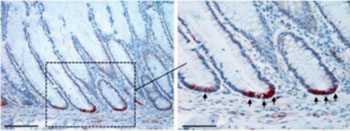Colon Cancer Cells Adopt Stem Cell Characteristics to Metastasize to the Liver
By LabMedica International staff writers
Posted on 13 Jul 2015
Cancer researchers have identified an interlocked set of enzyme activities, similar to those found in stem cells, expressed in colorectal cancer (CRC) cells, which confer on these cells the enhanced cellular motility required for metastasis into the liver.Posted on 13 Jul 2015
Investigators at the Weizmann Institute of Science (Rehovot, Israel) worked with mouse models of colorectal cancer metastasis to the liver. The first gene they linked to metastasis was L1. L1 family members are able to bind to a number of other proteins. As cell adhesion molecules, they often bind "homophilically" to themselves; for example L1 on one cell binding to L1 on an adjacent cell. L1 family members also bind "heterophilically" to members of the contactin or CNTN1 family. In addition, L1 family members bind to many cytoplasmic proteins such as ezrin-moesin-radixin (ERM) proteins and to various signaling molecules and proteins important in trafficking.

Image: Normal human colonic crypts are pictured. SMOC-2 expression (red) in the colonic stem cells demonstrates that these cells are localized in the bottoms of the crypts. Bars represent 100 micrometers (left) and 50 micrometers (right) (Photo courtesy of the Weizmann Institute of Science).
The investigators reported in the April 27, 2015, online edition of the journal Oncogene that L1 could confer enhanced motility and liver metastasis when expressed in CRC cells. This ability of L1-mediated metastasis was exerted by a mechanism involving ezrin and the activation of NF-kappaB target genes. Ezrin is a cytoplasmic peripheral membrane protein that functions as a protein-tyrosine kinase substrate in microvilli. As a member of the ERM protein family, ezrin serves as an intermediate between the plasma membrane and the actin cytoskeleton. It plays a key role in cell surface structure adhesion, migration, and organization and has been implicated in various human cancers.
In the present study, the investigators identified SMOC-2 (secreted modular calcium-binding matricellular protein-2) as a gene activated by L1-ezrin-NF-kappaB signaling. The induction of SMOC-2 expression in L1-expressing CRC cells was necessary for the increase in cell motility, proliferation under stress, and liver metastasis conferred by L1. SMOC-2 was localized at the bottom of normal human colonic crypts and at increased levels in CRC tissue with preferential expression in invasive areas of the tumor.
"This research," said senior author Dr. Avri Ben-Ze'ev, professor of genetics at the Weizmann Institute of Science, "provides support for the idea that as cancer develops, it also reverts—that is, some of its cells adopt a less mature, more stem-like, state that assists metastasis. Additional investigations into the interactions between SMOC-2 and other genes suggested that the human cancer cells were, indeed, taking on some qualities of stem cells. We hope that further research will point to ways of interfering with the activities of genes like SMOC-2, thus preventing this cancer from metastasizing. In addition, the expression patterns of SMOC-2 could make it an ideal marker for the early detection of human metastatic colorectal cancer."
Related Links:
Weizmann Institute of Science













